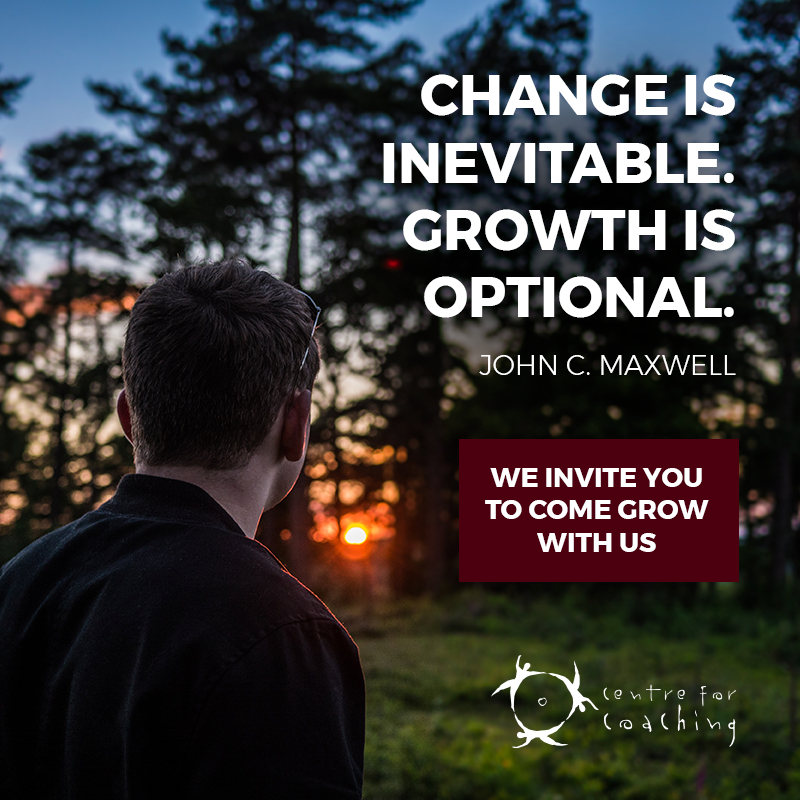By Janine Everson and Craig O’Flaherty, Directors of the Centre for Coaching, UCT Graduate School of Business
 Only a decade or so has passed since leading organisations began to access and integrate the modality of coaching into the running of their organisations. As with all new trends, there are always early-adopters, those who take the risk to experiment with a fresh application and make their mistakes until the impact starts to show — and the experimental phase is now over.
Only a decade or so has passed since leading organisations began to access and integrate the modality of coaching into the running of their organisations. As with all new trends, there are always early-adopters, those who take the risk to experiment with a fresh application and make their mistakes until the impact starts to show — and the experimental phase is now over.
“Organisations are starting to understand the power of a blended model — where both external and internal coaches can be integrated in a mix that services the key concerns of the organisation.”
The success that coaching has helped companies achieve has resulted in organisations scrambling to access and integrate this powerful tool into their human capital strategy. However, some discernable shifts are showing up in the trends of how and where it’s used.
What was once a buzz-word and fad has now become an application for engaging and developing managers and leaders at all levels of organisations in unique ways. One of the largest shifts taking place is that coaching is no longer being considered a skill, intervention, or process applied largely by external resources, to only the most senior levels of companies.
Affordability, linkage to confidential strategic outcomes and building of internal capacity are among the reasons for this shift. Now, that is beginning to be balanced by internal resources taking a more significant role.
SHIFT FROM EXTERNAL TO INTERNAL
In the early years, coaching was a strategic application, with resources hired externally and applied where it could be justified — at strategic (executive committee and board) levels in the organisation. The reasons for such resources being hired externally were sound:
- Coaching is a specialist skill and a relatively new competency and it didn’t exist in sufficient numbers internally.
- In the early days of coaching, executives wanted the privacy and confidentiality that external coaches provided (many still do).
- Organisations wanted the objective perspective that external coaches could offer to ensure a balanced way forward for leaders being coached and their evaluation of progress.
The last decade has seen notable shifts, with recent surveys showing where organisations1 which apply coaching, are using it:
- One-on-one coaching – 54 percent are using a mix of internal and external coaching resources for employees, managers, and leaders.
- Group and team coaching – 34 percent are beginning to use internal coaches to work at coaching teams of leaders, managers, and even supervisors, across the organisation as they work towards unifying themselves and their teams.
- Building internal coaching skills – 33 percent are starting to deliver coaching-skills training to leaders, managers, and internal coaches-in-training internally, instead of relying solely on external resources.

Some of the reasons driving these shifts are:
- Business case – Lowering the cost of external coaching, which although highly impactful can be prohibitively expensive. (How can we make coaching and leadership development more affordable?)
- Complexity of on-boarding – integration of external coaches requires time and effort, as well as trying to ensure that coaches with different approaches are headed in the same direction and the realisation that internal resources are needed to manage coaching relationships.
- Clear focus on the organisation’s need for retention – ensuring that a front-of-mind outcome of coaching is the retention of key leaders and staff, rather than coaching them out of a role or the business as a whole.

CASE STUDY1
EQUIPPING HR LEADERS TO COACH
A large bank wanted its HR leaders to become role models of coaching competence and to be able to excite the divisional leaders they worked with into understanding the impact of coaching skills. Over a three-year period, senior HR executives across the organisation were invited into a 6 month ACC programme with the Centre for Coaching to learn and embody coaching skills. The programme entailed learning the theory of coaching, being coached themselves, and having clients with whom they worked to embed the skills over that period.
This programme was designed to balance the mix between external and internal resources being applied to coaching. Of the 100 who attended the programme, 60 are now in key leadership roles and providing coaching to high-performing resources in the organisation.
The applications of internal coaching
Organisations are starting to understand the power of a blended model — where both external and internal coaches can be integrated in a mix that services the key concerns of the organisation. This model is being applied to some specific outcomes.
Firstly, that of building and entrenching a coaching culture, in other words working with leaders and managers in a way that gets the skills of deep listening and incisive questioning (two key coaching competencies) embedded in ways that influence many kinds of interaction.
Secondly, needing and wanting to build leadership, technical and behavioural competencies at all levels, rather than just higher up in the system.
Thirdly, tailoring the development process of coaching to ensure that both the individual’s unique needs and levels of competency are balanced against the generic needs of the organisation as to what good looks like.
Although a core focus of external coaching as well, internal coaches have shown a real capacity and resilience to work towards these outcomes because of their access to and understanding of an organisation’s priorities. Recent surveys have shown that internal coaches have a unique concern for engaging with clients with a core focus on retention of staff, which significantly impacts the bottom line.
“Even if you are not a full-time coach in your organisation, coaching skills will help you in any interaction with people. Be it seeking input for a development program, having career discussions or solving problems, coaching capabilities enrich it and add an extra dimension. I am applying these skills pretty much on a daily basis and am amazed by the depth and wealth of conversations I am able to hold now.”
Tatiana Matveeva, Leadership Development Director, JT International, Geneva
CASE STUDY2
BUILDING NEW LEADERS
The challenge for this South African division of a global oil and gas organisation was to build a cadre of leaders of the future. The organisation, in partnership with the Centre for Coaching, realised that it needed the leaders of the future to learn to engage with themselves and their teams and clients in new ways by building their competency to have both powerful and courageous conversations, including coaching, and giving compelling feedback.
A process was set into place which would equip these leaders-in-training to learn how to coach, to work in coaching-circles (groups of peers who coach one another), and to work with external coaches to enable the transfer of coaching skills across to them. The programme* is now in its fourth year and organisational feedback centres on how they have stepped into their leadership roles in a more impactful way.
*This programme won the Chevron Global external training programme award in 2013 out of all programmes delivered externally to Chevron employees world-wide.
CASE STUDY3
CASCADING COACHING
An industry-leading, fast-moving consumer goods organisation was taken over by an international CEO who wanted to cascade the competence of coaching to the shop floor. In an organisation wide programme, all 2 000 employees over a period of three years were exposed to and equipped with coaching skills.
While these were transferred across by an external team of facilitators, from the Centre for Coaching, the emphasis was on leaving the language of coaching behind. In waves of offsite and on the shop floor interventions, the organisation was exposed to coaching and then encouraged and supported to apply this as part of their daily responsibilities.
 Other factors at play
Other factors at play
Some other interesting trends have emerged. Having coaching skills inserted in the organisation, either in full-time roles or applied as part of leadership skills, has helped organisations to achieve additional outcomes:
– HR downsizing – Worldwide trends show that after the ballooning of HR skills in the 80s and 90s, the new millennium has seen HR skills and budgets downsized. This has meant that HR professionals have many more priorities to handle, with less capacity, and little ability to keep being the sole guardians of delivering applications like coaching. Managers and leaders are needing to step into coaching and developing staff for themselves, without it being an HR default responsibility.
– Midwives for Change – Once again, leaders and managers need to become ‘mid-wives’ for the changes that their teams and direct reports are encountering and the need for coaching skills is essential. Knowing who to coach, when to coach and how to coach are becoming less of a choice and more of an imperative.
– Transferring Skills – among mobile talent, in particular young high potentials within multinationals and large organisations, transferring skills is key, and the need for internal coaches on hand to hardwire new learning through providing insight, challenge, and support, is growing exponentially.
“Working in a multicultural environment, cohesion is often difficult to maintain – being now equipped with skills learned on the Associate Coaching Course has allowed me to significantly improve my anticipation and capacity to resolve issues as they arise, as well as improving my capacity to build the professional capabilities of those I work with”.
Eric Maire, International Business Management Consultant, Lausanne

Future trends
The swing away from coaching as solely an externally applied resource, to where it becomes a balanced offering between external provision of coaching services and the building of internal coaching capacity, will continue.
The fundamental outcome of any coaching is to leave an individual, a team or even system to be self-correcting (able to identify issues and resolve them) and self-generating (able to apply the learning gained from coaching to other areas and make the changes themselves). So, the balance between outside-in (external coaches) and inside-out (internal coaches) resources working in partnership to build that capacity is an outcome worth achieving.
 Centre for Coaching (Switzerland):
Centre for Coaching (Switzerland):
Established in 2002, the Centre for Coaching, an internationally accredited Centre for executive coach training and leadership development, is situated at the University of Cape Town’s Graduate School of Business (GSB), and is present in South Africa, Australia and Switzerland. Its courses form part of the GSB Executive Education suite of offerings and are thus informed by both academic rigour and coaching practice. The Centre for Coaching links into over 25 years of cutting edge coaching course development and experience offered through its alliance with New Ventures West in San Francisco.
1 2014 Building a Coaching Culture Final Report (International Coach Federation) http://coachfederation.org/about/landing.cfm?ItemNumber=3674&navItemNumber=3675
2013 ICF Organizational Coaching Study (International Coach Federation) http://coachfederation.org/about/landing.cfm?ItemNumber=827&navItemNumber=799
Update on the Centre for Coaching and it’s contribution to the Graduate School of Business, Cape Town https://oldweb.centreforcoaching.ch/the-centre-for-coaching/




